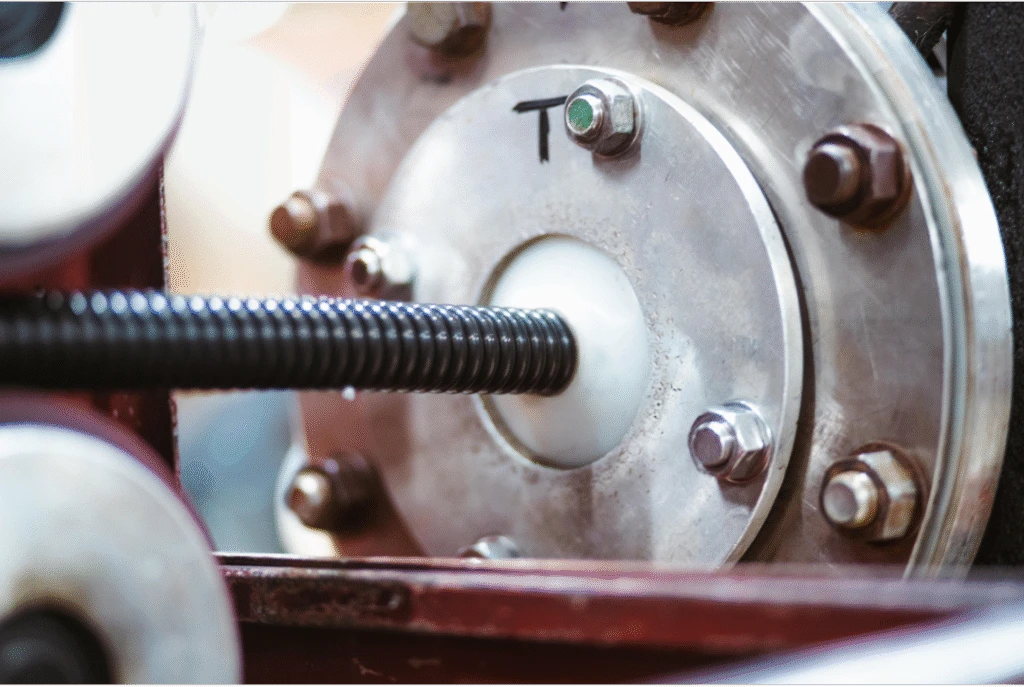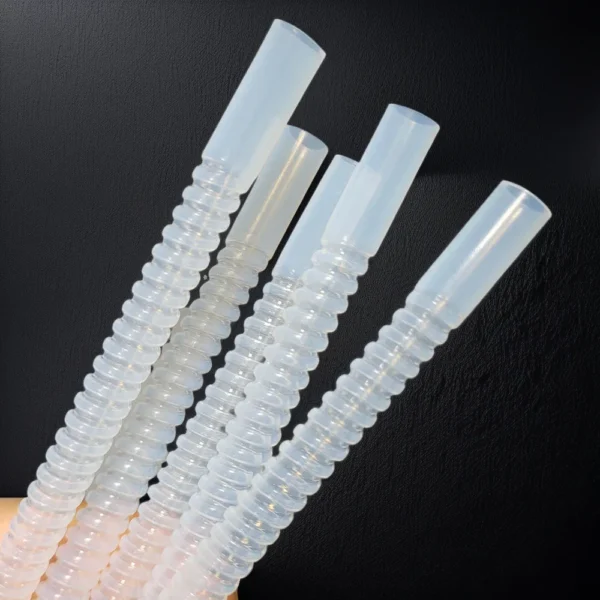Pernahkah Anda menatap lembar spesifikasi untuk tabung PTFE dan merasa bahwa itu ditulis dalam bahasa lain? Ya, saya juga, saat pertama kali terjun ke bidang ini. Saya berbicara tentang daftar angka dan istilah yang tak ada habisnya yang membuat mata Anda berkaca-kaca. Tapi begini: setelah Anda menguraikannya, spesifikasi tabung PTFE bukanlah kode misterius - itu hanya info praktis untuk menjaga agar pengaturan Anda tetap lancar. Jika Anda terjun ke industri seperti pemrosesan kimia atau otomotif, di mana bahan ajaib yang fleksibel ini muncul di mana-mana, memahami dasar-dasar ini dapat menyelamatkan Anda dari sakit kepala (dan uang) di kemudian hari.
Pada bagian ini, kita akan membahas tentang tiga hal utama: peringkat tekanan, kisaran suhu, dan radius tikungan. Saya akan mengambil dari pengalaman kerja selama bertahun-tahun di Teflon X, tempat kami memasok pipa untuk segala hal, mulai dari eksperimen laboratorium hingga saluran bahan bakar tugas berat. Tanpa basa-basi, hanya bicara langsung untuk membantu Anda mengetahui apa yang penting. Dan jika ada sesuatu yang menarik dan Anda ingin mengobrol tentang proyek Anda, hubungi halaman kontak atau kirimkan email ke Allison.Ye@teflonx.com. Mari menyelam lebih dalam.
Apa Itu Tabung PTFE?
Bayangkan ini: tabung yang sangat tangguh dan licin, yang dapat bertahan dalam menghadapi bahan kimia dan suhu yang ekstrem. Itu adalah PTFE-polytetrafluoroethylene, jika Anda ingin menjadi lebih mewah. Ini adalah bahan di balik lapisan Teflon pada panci anti lengket Anda, tetapi dalam bentuk industri, bahan ini merupakan pengubah permainan untuk menyalurkan cairan tanpa kebocoran atau kerusakan.
Mengapa peduli? Di tempat-tempat seperti pabrik kimia atau peralatan medis, selang karet biasa tidak bisa mengatasinya. Pipa PTFE tahan terhadap korosif, tetap fleksibel, dan tidak terdegradasi seperti opsi yang lebih murah. Di Teflon X, kami telah melihatnya digunakan dalam pengaturan di mana kegagalan bukanlah suatu pilihan, seperti mentransfer pelarut yang keras. Kami Saluran Bahan Bakar PTFE untuk pabrik pengolahan bahan kimia, misalnya, dibuat tangguh untuk skenario tersebut-menangani bahan bakar dan asam tanpa hambatan, dengan lubang bagian dalam yang halus yang mengurangi hambatan dan meningkatkan aliran.
Tapi spesifikasi? Itu adalah peta jalan. Tanpa mereka, Anda hanya menebak-nebak, dan menebak-nebak dalam bidang teknik adalah cara cepat menuju kekacauan yang mahal.
Membongkar Spesifikasi Tabung PTFE
Baiklah, mari kita bahas dagingnya. Spesifikasi tabung PTFE bermuara pada seberapa besar hukuman yang dapat diterimanya - panas, remasan, puntiran - sebelum akhirnya putus. Kami akan membahas hal-hal penting yang Anda sebutkan: peringkat tekanan, kisaran suhu, dan radius tikungan. Saya akan membuatnya tetap nyata dengan contoh-contoh dari lapangan, bukan hanya hal-hal yang ada di buku teks.
Kisaran Suhu: Bertahan dari Panas (atau Beku)
Kisaran suhu pada dasarnya adalah seberapa panas atau dingin pipa Anda tanpa berubah menjadi genangan air atau retak seperti es. Untuk PTFE standar, rentangnya sangat lebar: dari -200°C (-328°F) hingga +260°C (+500°F). Itu cukup dingin untuk laboratorium kriogenik dan cukup panas untuk saluran uap.
Mengapa hal ini penting bagi seorang pemula? Katakanlah Anda sedang mengalirkan cairan pendingin di bengkel mesin-jatuhkan di bawah titik beku, dan bahan yang rapuh akan hancur. Atau memutar panas di dalam reaktor, dan meleleh. Kami memiliki klien di Teflon X yang mengabaikan hal ini dan berakhir dengan garis yang melengkung setelah suatu batch terlalu panas. Pelajaran yang dipetik: selalu sesuaikan kisaran dengan skenario terburuk Anda.
Untuk memperjelasnya, berikut ini adalah tabel singkat dengan kisaran tipikal untuk ukuran umum, yang diambil dari data teknik yang dapat diandalkan. (Catatan: ini adalah pada suhu kamar; suhu ekstrem akan sedikit mengubah performa.)
| Ukuran tabung (ID x OD dalam inci) | Suhu Min (°F) | Suhu Maksimum (°F) | Kasus Penggunaan Umum |
|---|---|---|---|
| 1/16 x 1/8 | -328 | 500 | Laboratorium mikrofluida |
| 1/4 x 3/8 | -328 | 500 | Transfer bahan kimia |
| 1/2 x 5/8 | -328 | 500 | Selang industri |
Lihat? Serbaguna. Tapi ingat, paparan yang terlalu lama di dekat bagian tepi-seperti suhu konstan 500°F-dapat memperpendek usia pakai. Kiat pro dari pengalaman saya: panaskan terlebih dahulu dengan lembut jika Anda menekuknya dengan panas untuk menghindari retakan akibat tekanan.
Peringkat Tekanan: Berapa Banyak Tekanan yang Dapat Ditangani?
Selanjutnya, peringkat tekanan. Ini memberi tahu Anda psi maksimum (pound per inci persegi) yang dapat ditanggung oleh pipa sebelum pecah atau bocor. Hal ini bervariasi berdasarkan ketebalan dinding dan diameter-dinding yang lebih tebal berarti peringkat yang lebih tinggi.
Untuk tabung 1/16″ ID x 1/8″ OD, Anda akan mendapatkan tekanan kerja sekitar 290 psi. Tingkatkan hingga 1/4″ OD dinding tebal, dan tekanannya melonjak hingga 1.000 psi atau lebih. Tekanan semburan biasanya 4x lipat dari itu, jadi margin keamanan sudah ada.
Dalam praktiknya? Bayangkan memompa cairan hidraulik dalam sebuah mesin press-jika saluran Anda dinilai terlalu rendah, boom, waktu henti. Saya ingat sebuah perusahaan kimia kecil yang kami bantu; saluran PVC lama mereka meledak pada 200 psi saat terjadi lonjakan. Beralih ke barang PTFE kami, dan mereka telah solid pada 400 psi stabil. Periksa spesifikasi pompa Anda terhadap hal ini, dan perhitungkan lonjakan - tambahkan buffer 20-30% jika Anda paranoid (yang seharusnya).
Tabel cepat untuk peringkat tekanan di seluruh ukuran:
| Ukuran (ID x OD) | Ketebalan Dinding (dalam) | Tekanan Kerja (psi @ 73°F) | Tekanan Semburan (psi) |
|---|---|---|---|
| 1/16 x 1/8 | 0.031 | 290 | 1,160 |
| 1/4 x 3/8 | 0.062 | 600 | 2,400 |
| 1/2 x 3/4 | 0.125 | 350 | 1,400 |
Ini sudah teruji di laboratorium; cairan dunia nyata seperti minyak mungkin akan membuat mereka sedikit terganggu.
Tikungan Radius: Memutar Tanpa Drama
Radius tikungan adalah tikungan paling rapat yang dapat Anda buat tanpa membuat tabung tertekuk atau melemahkannya. Terlalu tajam, dan aliran akan terhambat atau retak seiring waktu. Minimum biasanya 4-6 kali OD- jadi untuk tabung OD 1/8″, itu sekitar 0,5-0,75 inci.
Dari apa yang saya lihat, untuk garis OD 1/16″, serendah 4mm untuk tikungan statis. Yang lebih besar, seperti 3/4″ OD, membutuhkan 6 inci atau lebih. Panaskan terlebih dahulu (sekitar 200°C) untuk tikungan permanen, dan Anda bisa lebih kencang tanpa masalah.
Mengapa ribut? Di ruang mesin yang sempit, tikungan yang buruk membuat aliran ke hilir terhenti. Salah satu klien-pembuat suku cadang mobil-mengalami kegagalan yang terputus-putus akibat jalur yang terjepit pada robot perakitannya. Kami mengubah rute dengan perhitungan radius yang tepat, menggunakan Saluran Bahan Bakar PTFEdan output melonjak 15%. Perbaikan sederhana, kemenangan besar.
Tabel untuk jari-jari tikungan:
| OD (inci) | Radius Tikungan Min (inci) | Catatan |
|---|---|---|
| 1/16 | 0,16 (4mm) | Statis, suhu ruangan |
| 1/4 | 1 | Aplikasi dinamis |
| 3/4 | 6 | Hindari belokan tajam |
Kemenangan Kehidupan Nyata: PTFE dalam Aksi
Spesifikasinya memang keren, tetapi melihatnya bekerja? Itulah yang menjadi daya tariknya. Ambil contoh tempat pembuatan bir berukuran sedang yang kami suplai tahun lalu. Mereka membutuhkan saluran untuk transfer wort panas - suhu mencapai 180 ° F, tekanan sekitar 50 psi, dan mengular melalui tong dengan tikungan yang ketat. Silikon standar akan meleleh atau tertekuk; spesifikasi tabung PTFE kami memakukannya: kisaran suhu penuh, penahan tekanan padat, dan tikungan hingga 2 inci tanpa kehilangan aliran. Hasilnya? Tidak ada kebocoran dalam enam bulan, dan mereka meningkatkan produksi tanpa retooling.
Atau pikirkan pemrosesan kimia: kami Saluran Bahan Bakar PTFE bersinar di sini, dirancang untuk cairan agresif seperti asam atau bahan bakar. Satu pabrik anonim (tidak dapat menyebutkan namanya, barang NDA) memotong perawatan sebesar 40% setelah menukar spesifikasi tersebut yang berarti tidak ada lagi pembengkakan atau ledakan selama uji tekanan.
Ini bukan hipotetis; ini berasal dari kutipan yang telah kami tangani. Jika penyiapan Anda terdengar mirip, telusuri teflonx.com mungkin akan memunculkan ide.
Menghindari Jebakan yang Sering Dihadapi Pemula
Lihatlah, kita semua pernah mengalaminya-ambil tabung yang paling murah, abaikan cetakan kecilnya, lalu berebut ketika gagal. Kesalahan umum: mengabaikan bagaimana suhu menurunkan peringkat tekanan. Pada suhu 500°F, garis 600 psi itu bisa berkurang setengahnya. Atau memaksa menekuk terlalu kencang, yang menyebabkan retakan akibat kelelahan setelah beberapa siklus.
Saran saya? Mulailah dengan lingkungan Anda-daftar panas maksimum, puncak psi, dan sketsa rute. Kemudian cocokkan dengan spesifikasi. Alat seperti kalkulator radius tikungan online membantu, tetapi tidak ada yang bisa mengalahkan pengujian sampel. Di Teflon X, kami menawarkan konsultasi gratis untuk menghitung angka untuk Anda.
FAQ: Hit Cepat pada Spesifikasi Tabung PTFE
Apa masalahnya dengan penurunan peringkat tekanan pada suhu tinggi?
Ya, panas melunakkan segala sesuatunya, sehingga peringkatnya turun-mungkin 50% secara ekstrem. Selalu turunkan untuk keamanan; periksa grafik dari standar ASTM untuk mengetahui secara pasti.
Dapatkah saya menggunakan tabung PTFE untuk barang food grade?
Tentu saja, jika memenuhi persyaratan FDA. Produk kami memenuhi hal itu, bagus untuk pabrik bir atau farmasi. Cukup konfirmasikan kelasnya.
Bagaimana cara mengukur jari-jari tikungan dengan benar?
Dari garis tengah ke kurva bagian dalam. Gunakan templat atau string-mudah sekali. Untuk titik-titik dinamis, tambahkan margin 20%.
Apakah ada spesifikasi PTFE yang cocok untuk semua?
Nah, tergantung pada kebutuhan aliran Anda. ID yang lebih kecil untuk presisi, lebih besar untuk volume. Hubungi kami untuk mendapatkan informasi lebih lanjut.
Mengakhiri: Langkah Anda Selanjutnya
Itu dia - ikhtisar tanpa BS tentang spesifikasi tabung PTFE, mulai dari tekanan peringkat tekanan hingga tikungan radius tikungan. Berbekal ini, Anda siap untuk memilih pipa yang tidak akan mengecewakan Anda, baik itu penyesuaian di laboratorium atau perombakan pabrik secara menyeluruh. Terasa menyenangkan, bukan? Kepercayaan diri untuk menangani proyek tanpa menebak-nebak.
Jika hal ini memicu pertanyaan atau Anda siap untuk mengutip Saluran Bahan Bakar PTFE, jatuhkan baris di Allison.Ye@teflonx.com atau kunjungi halaman halaman kontak. Kami di sini untuk memudahkan Anda-mari kita bicarakan apa yang cocok untuk Anda. Apa kekhawatiran spesifikasi terbesar Anda? Ceritakan di komentar atau email; saya ingin mendengarnya.
Saluran Bahan Bakar PTFE untuk Pabrik Pengolahan Kimia
Pipa bahan bakar PTFE, dibuat sebagai selang bahan bakar bergelombang PTFE, unggul dalam memindahkan cairan korosif di pabrik kimia. Kelembaman kimianya menahan asam dan pelarut. Desain pipa bahan bakar bergelombang yang tahan lama menangani tekanan tinggi dan siklus termal, memastikan pemindahan cairan yang andal dan rendah gesekan.



